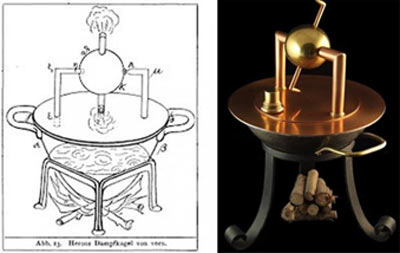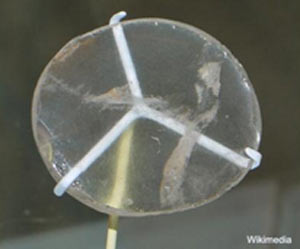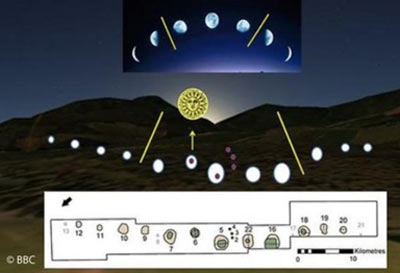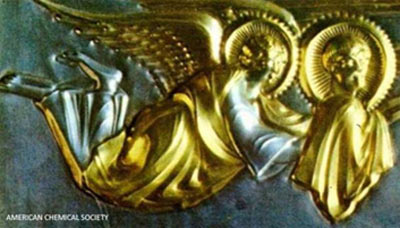10 Amazing Inventions
Dating back thousands of years are numerous examples of ancient technology that leave us awe-struck at the knowledge and wisdom held by people of our past. They were the result of incredible advances in engineering and innovation as new, powerful civilizations emerged and came to dominate the ancient world. These advances stimulated societies to adopt new ways of living and governance, as well as new ways of understanding their world. However, many ancient inventions were forgotten, lost to the pages of history, only to be re-invented millennia later. Here we feature ten of the best examples of ancient technology and inventions that demonstrate the ingenuity of our ancient ancestors.
1. The ancient invention of the steam engine by the Hero of Alexandria

Heron Alexandrinus, otherwise known as the Hero of Alexandria, was a 1st century Greek mathematician and engineer who is known as the first inventor of the steam engine. His steam powered device was called the aeolipile, named after Aiolos, God of the winds. The aeolipile consisted of a sphere positioned in such a way that it could rotate around its axis. Nozzles opposite each other would expel steam and both of the nozzles would generate a combined thrust resulting in torque, causing the sphere to spin around its axis. The rotation force sped up the sphere up to the point where the resistance from traction and air brought it to a stable rotation speed. The steam was created by boiling water under the sphere – the boiler was connected to the rotating sphere through a pair of pipes that at the same time served as pivots for the sphere. The replica of Heron’s machine could rotate at 1,500 rounds per minute with a very low pressure of 1.8 pounds per square inch. The remarkable device was forgotten and never used properly until 1577, when the steam engine was ‘re-invented’ by the philosopher, astronomer and engineer, Taqu al-Din.
2. Is the Assyrian Nimrud lens the oldest telescope in the world?

The Nimrud lens is a 3,000-year-old piece of rock crystal, which was unearthed by Sir John Layard in 1850 at the Assyrian palace of Nimrud, in modern-day Iraq. The Nimrud lens (also called the Layard lens) is made from natural rock crystal and is a slightly oval in shape. It was roughly ground, perhaps on a lapidary wheel. It has a focal point about 11 centimetres from the flat side, and a focal length of about 12 cm. This would make it equivalent to a 3× magnifying glass (combined with another lens, it could achieve much greater magnification). The surface of the lens has twelve cavities that were opened during grinding, which would have contained naptha or some other fluid trapped in the raw crystal. Since its discovery over a century ago, scientists and historians have debated its use, with some suggesting it was used as a magnifying glass, and others maintaining it was a burning-glass used to start fires by concentrating sunlight. However, prominent Italian professor Giovanni Pettinato proposed the lens was used by the ancient Assyrians as part of a telescope, which would explain how the Assyrians knew so much about astronomy. According to conventional perspectives, the telescope was invented by Dutch spectacle maker, Hans Lippershey in 1608 AD, and Galileo was the first to point it to the sky and use it to study the cosmos. But even Galileo himself noted that the ‘ancients’ were aware of telescopes long before him. While lenses were around before the Nimrud lens, Pettinato believes this was one of the first to be used in a telescope.
3. The Oldest Calendar in Scotland

Research carried out last year on an ancient site excavated by the National Trust for Scotland in 2004 revealed that it contained a sophisticated calendar system that is approximately 10,000 years old, making it the oldest calendar ever discovered in the world. The site – at Warren Field, Crathes, Aberdeenshire – contains a 50 metre long row of twelve pits which were created by Stone Age Britons and which were in use from around 8000 BC (the early Mesolithic period) to around 4,000 BC (the early Neolithic). The pits represent the months of the year as well as the lunar phases of the moon. They were formed in a complex arc design in which each lunar month was divided into three roughly ten day weeks – representing the waxing moon, the full moon and the waning moon. It also allowed the observation of the mid-winter sunrise so that the lunar calendar could be recalibrated each year to bring it back in line with the solar year. The entire arc represents a whole year and may also reflect the movements of the moon across the sky.
4. Ancient Roman Concrete was Far Superior to Our Own

Scientists studying the composition of Roman concrete, which has been submerged under the Mediterranean Sea for the last 2,000 years, discovered that it was superior to modern-day concrete in terms of durability and being less environmentally damaging. The Romans made concrete by mixing lime and volcanic rock. For underwater structures, the combination of lime and volcanic ash with seawater instantly triggered a chemical reaction in which the lime incorporated molecules into its structure and reacted with the ash to cement the whole mixture together. Analysis of the concrete found that it produces a significantly different compound to modern day cement, which is an incredibly stable binder. In addition, the ancient concrete contains the ideal crystalline structure of Tobermorite, which has a greater strength and durability than the modern equivalent. Finally, microscopic studies identified other minerals in the ancient concrete which show potential application for high-performance concretes, including the encapsulation of hazardous wastes. “In the middle 20th century, concrete structures were designed to last 50 years,” said scientist Paulo Monteiro said. “Yet Roman harbour installations have survived 2,000 years of chemical attack and wave action underwater.”
5. 2000-year-old metal coatings superior to today’s standards

Research has shown that artisans and craftsmen 2,000 years ago used a form of ancient technology for applying thin films of metal to statues and other items, which was superior to today’s standards for producing DVDs, solar cells, electronic devices and other products. Fire gilding and silvering are age-old mercury-based processes used to coat the surface items such as jewels, statues and amulets with thin layers of gold or silver. From a technological point of view, what the ancient gilders achieved 2000 years ago, was to make the metal coatings incredibly thin, adherent and uniform, which saved expensive metals and improved its durability, something which has never been achieved to the same standard today. Apparently without any knowledge about the chemical–physical processes, ancient craftsmen systematically manipulated metals to create spectacular results. They developed a variety of techniques, including using mercury like a glue to apply thin films of metals to objects. The findings demonstrate that there was a far higher level of understanding and knowledge of advanced concepts and techniques in our ancient past than what they are given credit for.
Leave a Reply